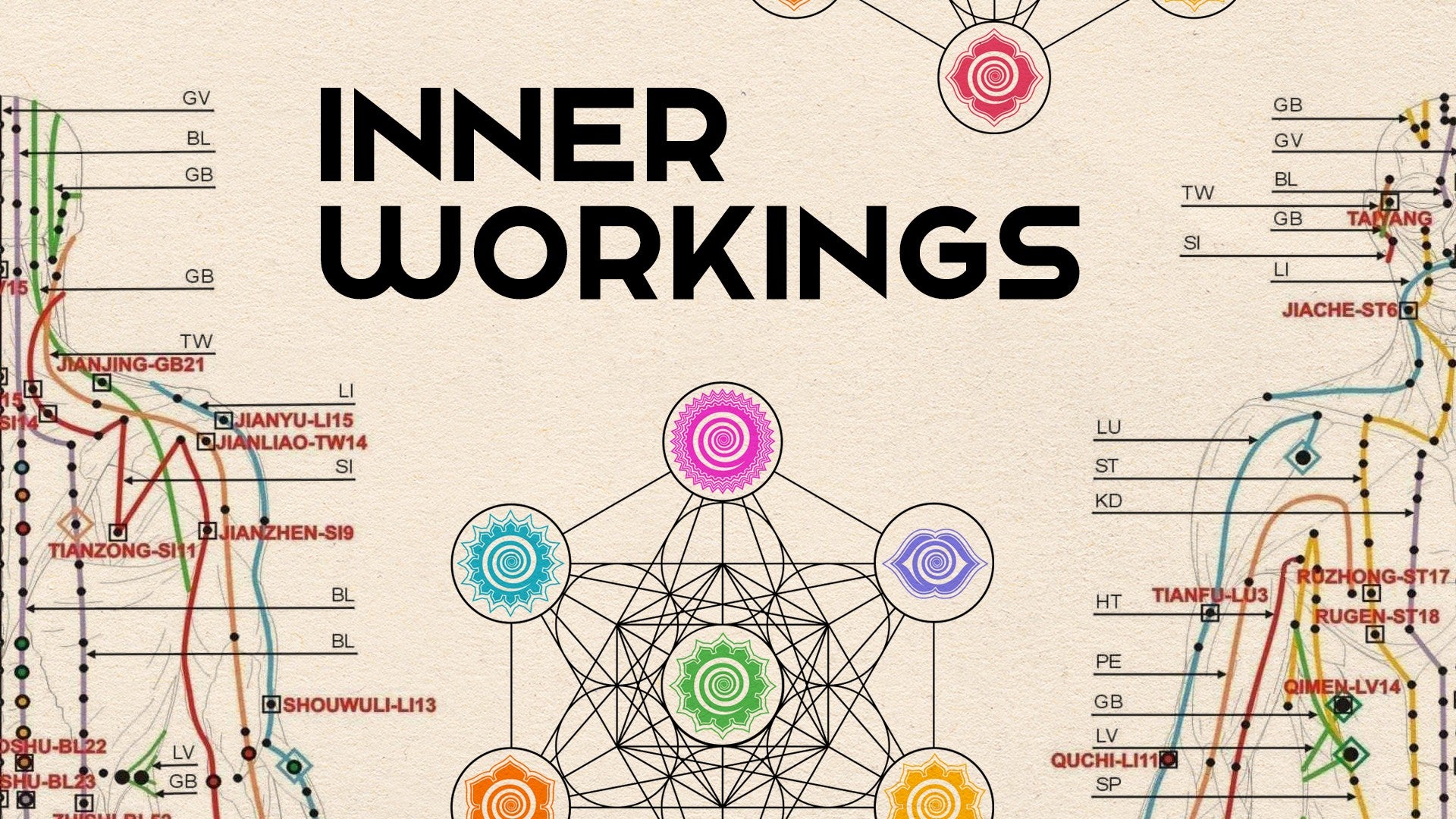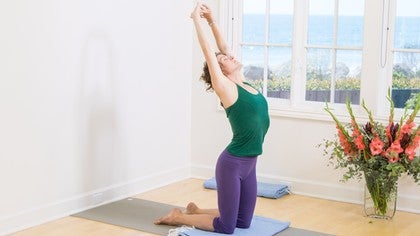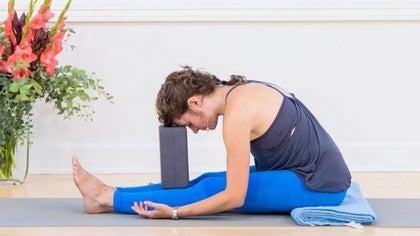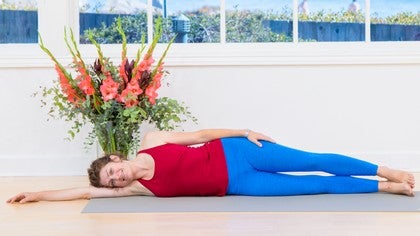Description
About This Video
Transcript
Read Full Transcript
In this episode we're going to continue our progress at the spine. We've worked with Muradara, with Svaristana and Manipura together, with Anahata and Vishuddha together. And now we're going to work with the individual experience and the relationships between Ajna chakra and Sahasrata chakra at the crown. So I'm sitting in Virasana on a block. I have a foam block underneath my seat. It's turned this way. You can see. This is just a comfortable seat for me. If your seat is more comfortable cross-legged or even in a chair, those are great places to do this work. The first thing we're going to do is the breathing practice Nadi Shuddhanam. You'll use your thumb of your dominant hand and your ring finger very gently against the curve of the top of the nostrils. So there's a little notch above the curve of the nostril and below the bone of the nose and your fingers will fit there. I'm going to ask you not to push. It's tempting to push and I may even in my language indicate that you could control the movement of your breath with your hand. But the hand is really just to indicate to your consciousness where the breath might go. The middle two fingers in Nadi Shuddhanam we don't generally use partially because they're kind of bossy. You can use them to touch your skin between the eyebrows. This is not where Ajahn Chakra is because Ajahn Chakra is deep inside the skull. It's at the center of the skull. So at the level of the of the temples front to back but at the level of the of the joining between the eyebrows side to side. So if it feels comfortable, if your fingers are the right length and your fingers rest there, you can set the fingers there to help you begin to move into this center in the skull. I'll be doing it along with you and I'll give some guidance about how the breath moves. But the basic principle is that after each inhalation you switch sides. You switch nostrils with the breath and again the temptation will be to push and I'm asking you not to push but just to switch your awareness and you can apply very gentle pressure just with the tip of the finger if you'd like. So we'll begin just by feeling the breath. You can bring the ring finger in the thumb. You can bring the two middle fingers to Ajahn Chakra and then the the palm is is cupped underneath the nostrils and you can feel the breath. So in my body the right nostril is more dominant right now. So in my patterning I'm gonna work starting by breathing out through the right nostril and in through the right nostril and I'll end by breathing out through the left nostril and in through the left nostril in keeping with the general focus in the yoga practice of encouraging and supporting balance. If your other nostril, your left nostril, is more open you can start with that or you can start with me. It doesn't matter that much. So first we'll just feel the breath and then on my next inhalation I'll emphasize the breath that's already there in the right nostril and then I'll breathe out through the left nostril imaginarily. Breathe in through the left nostril and switch to breathing out through the right. So if you find yourself tempted to apply pressure, instead you can touch less on the side that you're breathing through. Shifting after the inhalation, breathing out through the left side, shifting after the inhalation, breathing out through the right. As much as possible you're using your normal breath here. The mind is drawn toward the touch of the two fingers on the forehead and the prana is drawn with the mind. You can imagine the breath itself coming up through the right nostril and traveling deep into the skull, upwards, across and down the left side of the skull. The breath traveling in the left nostril coming up and across through the center, through Ajahnachakra and over the right side.
And then as I said we'll finish on the left side. So you'll exhale on the left, inhale on the left and release the hand breathing normally. After any pranayama, even now in my life when I have quite a bit of experience with pranayama, I really want to settle in and check in with the body and make sure that there wasn't any forcing happening. See if there's anywhere that's sore or that's particularly calling my attention or my awareness and support that with my normal breath. Okay so we're gonna move into a forward fold. I'll have you use a blanket. If when you come on to your blanket with your seat you feel like the back of the pelvis is still really falling toward the blanket, it'll be hard to get the the gravity feeling in the forehead that we're looking for here and so I really encourage you to elevate the pelvis as much as you need to to get the feeling of release forward that we're looking for. If you elevate the pelvis and still you don't get the falling feeling in the upper body, you feel still somewhat caught back, you can use a chair here over the legs and it'll give you a place to put the arms and you can rest the forehead against the edge of the chair maybe with something soft like a blanket over it. I'm gonna use a block for my forehead. So I'm just gonna inhale here and as I exhale I'm gonna release from the pelvis side to side allowing the body to fall around me like a cape until the forehead comes down. When you can see I'm not pulling this is a settling. I'm feeling how I can allow the weight of the skull to travel through the center and into the support. I'm feeling for the connection or release of energy toward the crown of the head as the weight gets out of the way. And I'm doing that very consciously, if not very actively. Mmm okay so let's come out. That feels very nice to me. Now the next piece we're gonna apply some some pressure to the face and we're gonna cradle the face in the hands and it's possible to do it here this way if you're very comfortable here but I'm gonna switch to being in my child's pose and you may also want to do that. So here I am in child's pose and my elbows are down my knees are wide enough that I'm comfortable and I'm gonna bring the thumbs underneath the chin and the hands to the sides of the head. In fact I'm going to tuck my thumbs sort of back behind my ears along the chin but you may find that you want yours across the front. This is very personal. What you're trying to do is catch the weight of the head in the hands. And here you may feel the roof of the mouth, the base of the skull, the sinuses, the temples. Those are all landmarks surrounding the central cavity that we're interested in here. And continuing that exploration when you come out we're going to use the fingers to press on the face and we'll make a pattern from the center out to the temples and then you can do a soft circle and then we'll come back to the center again and we're gonna start from just underneath the nose and gently press out underneath the collar the cheekbones to the temples and circle and then come further in and you can do this seated with gentle presses or you can do it with the support of the floor for the contact. So from the space just underneath the nose where you were feeling the breath before and you'll feel the breath now on the tips of the fingers and you'll press gently all the way out to the temples and make a gentle circle there emphasizing that the temples are related to Ajna Chakra in the same way that the point between the eyebrows is related and then we'll come to the bridge of the nose the place where you were resting the fingers before and press and circle and then higher on the nose toward the inside of the eye and you'll press along the occipital orb here that the surrounding of the eye all the way out and then from above the eye you'll press inside and along the underside of the eyebrow circling and then we'll do the forehead above the eyebrow I find this really nice when I'm sick or feeling sinusy you just have to be very gentle and then we'll come from the Ajna Chakra kind of orientation point and press all the way out it's juicier than you'd think that forehead bone and then circles and then the hairline pressing and circles and then finally we'll do the crown of the head the top of the head pressing all the way down to the temples and circles nice so let's come to downward dog now partially to bring weight into the top of the head to feel the weight come through the top of the head if your downward dog needs a little bit of time to unfold feel free to take the time I'm aware of the places where I've touched and I can look for receiving in those tissues you can wiggle around you can nod the head you can shake the head we're looking for the upward release of the brainstem the softening of the roof of the mouth and this very gentle very delicate feeling for the inside of the cranium and let's come down and set the knees down and we're just gonna gently roll from the forehead to the top of the head on the floor so you'll come back again to having the elbows down or the hands down and in your child's pose you can have the the feet flat or the or the toes folded and we're gonna set the forehead down on the floor and you want to do this very gently but you're just gonna roll from the forehead toward the crown run back if you have a headstand practice headstand is a very natural extension of this practice of getting to know and communicate with the upper chakras as they exist in your fleshy body not the idea of the chakras but the experience of them and then we'll come on out and you can pause for a moment and we'll come back to downward dog I can feel the weight of the brain the softness of the brain the fluidity of weight traveling through the tissue into the bones of the skull and it seems like there's always more to do I find as I'm here that I begin to hold the head again to draw it in and I can let it go again now when I get to the place where I find myself kind of drawing in creating flexion protecting and the response when I go to let go is not immediate then I'm gonna listen to that and come down encouraging proprioception by respecting the messages that we receive so the next piece before we come back to another round of nadi shodna the next piece is to have the experience of shifting the nostril so once you're very good at practicing nadi shodna there's that's one of the ways that you can use to balance the nostrils as we've been practicing my nostrils have evened out which is a very common experience when you work lovingly with the energy body so I don't have a particular side to choose to lie on but you might go ahead and check and see if your breath feels stronger in one side or the other if not it's fine we can just lie down and the breath will shift very often in my investigations into these upper chakras I can feel the limitation of the nostril from the inside from the roof of the mouth from the inner ear and you may find that when you experience the shift of the nostril that you experience the shift internally also so to make that shift we're just gonna lie down and you'll lie on the side that's more dominant you'll lie with the arm down and the pressure the compression of your weight against the floor and of the floor rising to meet you will send a inner body signal that will open the other nostril because it goes like this do your side not the side I'm doing unless this is your side and you want to get comfortable here so that you can stay long enough to feel the change happen a long time ago when I worked at the Himalayan Institute in New York City you were expected after you ate your lunch to lie down on your left side for 20 minutes so that your right nostril would be certain to be open while you're digesting the right nostril carries the energy of the Sun pingala and fire is very useful for digestion I often find that if I wake in the night I naturally want to shift to lying down on my right side so that my left nostril will be open the left nostril being the carrier of the inner energy the energy of the moon good for resting and going in because of the pattern of the Eden pingala nadis the right nostril corresponds with the left half of the brain and the left nostril with the right half of the brain you may find if you're exploring using your brain or the idea of your brain differently that playing with your nostrils helps you out there are times when I lie down on my side to shift a nostril and it won't happen sometimes when I'm getting sick I'll be on one nostril for a long time and not be able to shift it to the other one but sometimes the body just knows what it's doing a lot of times and you have to leave it alone I mean you never really leave your body alone right you have to stay there peacefully try not to get involved so now my left nostril is more dominant and I'm going to come up if you recall when we started my right nostril was more dominant so now I'll do my Nadi Shudnam the other way with beginning on the left and ending on the right and you can do yours in correspondence to your state using the ring finger and the thumb and I'll breathe in on the left and I'll imagine breathing out through the right nostril the breath descending from the left side of the cranium to the left of my crown chakra I'll breathe in on the right and breathe out through the left following this simple pattern at your own pace with your own natural breath settling into your seat finding a more comfortable seat if necessary I'll end with an inhalation on the right side and then I'll breathe out through both nostrils feeling the breath descend through the whole cranium thank you for practicing namaste
Inner Workings: Devon Riley
Comments
You need to be a subscriber to post a comment.
Please Log In or Create an Account to start your free trial.








